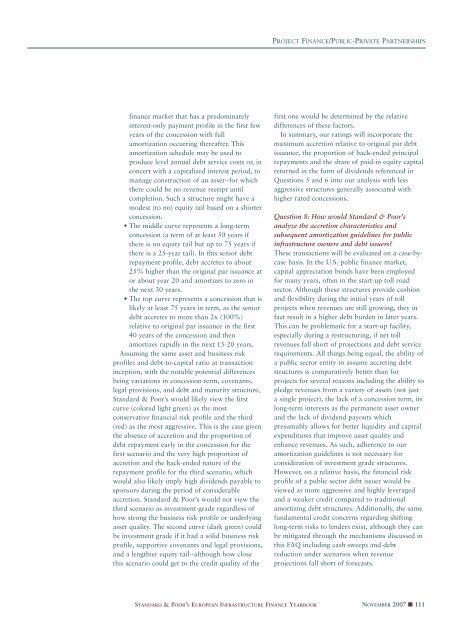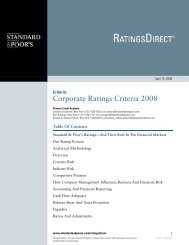European Infrastructure Finance Yearbook - Investing In Bonds ...
European Infrastructure Finance Yearbook - Investing In Bonds ...
European Infrastructure Finance Yearbook - Investing In Bonds ...
You also want an ePaper? Increase the reach of your titles
YUMPU automatically turns print PDFs into web optimized ePapers that Google loves.
finance market that has a predominately<br />
interest-only payment profile in the first few<br />
years of the concession with full<br />
amortization occurring thereafter. This<br />
amortization schedule may be used to<br />
produce level annual debt service costs or, in<br />
concert with a capitalized interest period, to<br />
manage construction of an asset--for which<br />
there could be no revenue receipt until<br />
completion. Such a structure might have a<br />
modest (to no) equity tail based on a shorter<br />
concession.<br />
• The middle curve represents a long-term<br />
concession (a term of at least 50 years if<br />
there is no equity tail but up to 75 years if<br />
there is a 25-year tail). <strong>In</strong> this senior debt<br />
repayment profile, debt accretes to about<br />
25% higher than the original par issuance at<br />
or about year 20 and amortizes to zero in<br />
the next 30 years.<br />
• The top curve represents a concession that is<br />
likely at least 75 years in term, as the senior<br />
debt accretes to more than 2x (100%)<br />
relative to original par issuance in the first<br />
40 years of the concession and then<br />
amortizes rapidly in the next 15-20 years.<br />
Assuming the same asset and business risk<br />
profiles and debt-to-capital ratio at transaction<br />
inception, with the notable potential differences<br />
being variations in concession term, covenants,<br />
legal provisions, and debt and maturity structure,<br />
Standard & Poor’s would likely view the first<br />
curve (colored light green) as the most<br />
conservative financial risk profile and the third<br />
(red) as the most aggressive. This is the case given<br />
the absence of accretion and the proportion of<br />
debt repayment early in the concession for the<br />
first scenario and the very high proportion of<br />
accretion and the back-ended nature of the<br />
repayment profile for the third scenario, which<br />
would also likely imply high dividends payable to<br />
sponsors during the period of considerable<br />
accretion. Standard & Poor’s would not view the<br />
third scenario as investment-grade regardless of<br />
how strong the business risk profile or underlying<br />
asset quality. The second curve (dark green) could<br />
be investment grade if it had a solid business risk<br />
profile, supportive covenants and legal provisions,<br />
and a lengthier equity tail--although how close<br />
this scenario could get to the credit quality of the<br />
STANDARD & POOR’S EUROPEAN INFRASTRUCTURE FINANCE YEARBOOK<br />
PROJECT FINANCE/PUBLIC-PRIVATE PARTNERSHIPS<br />
first one would be determined by the relative<br />
differences of these factors.<br />
<strong>In</strong> summary, our ratings will incorporate the<br />
maximum accretion relative to original par debt<br />
issuance, the proportion of back-ended principal<br />
repayments and the share of paid-in equity capital<br />
returned in the form of dividends referenced in<br />
Questions 5 and 6 into our analysis with less<br />
aggressive structures generally associated with<br />
higher rated concessions.<br />
Question 8: How would Standard & Poor’s<br />
analyze the accretion characteristics and<br />
subsequent amortization guidelines for public<br />
infrastructure owners and debt issuers?<br />
These transactions will be evaluated on a case-bycase<br />
basis. <strong>In</strong> the U.S. public finance market,<br />
capital appreciation bonds have been employed<br />
for many years, often in the start-up toll road<br />
sector. Although these structures provide cushion<br />
and flexibility during the initial years of toll<br />
projects when revenues are still growing, they in<br />
fact result in a higher debt burden in later years.<br />
This can be problematic for a start-up facility,<br />
especially during a restructuring, if net toll<br />
revenues fall short of projections and debt service<br />
requirements. All things being equal, the ability of<br />
a public sector entity to assume accreting debt<br />
structures is comparatively better than for<br />
projects for several reasons including the ability to<br />
pledge revenues from a variety of assets (not just<br />
a single project), the lack of a concession term, its<br />
long-term interests as the permanent asset owner<br />
and the lack of dividend payouts which<br />
presumably allows for better liquidity and capital<br />
expenditures that improve asset quality and<br />
enhance revenues. As such, adherence to our<br />
amortization guidelines is not necessary for<br />
consideration of investment grade structures.<br />
However, on a relative basis, the financial risk<br />
profile of a public sector debt issuer would be<br />
viewed as more aggressive and highly leveraged<br />
and a weaker credit compared to traditional<br />
amortizing debt structures. Additionally, the same<br />
fundamental credit concerns regarding shifting<br />
long-term risks to lenders exist, although they can<br />
be mitigated through the mechanisms discussed in<br />
this FAQ including cash sweeps and debt<br />
reduction under scenarios when revenue<br />
projections fall short of forecasts.<br />
NOVEMBER 2007 ■ 111



